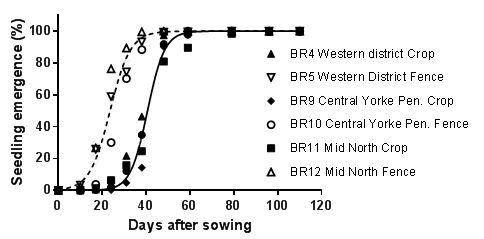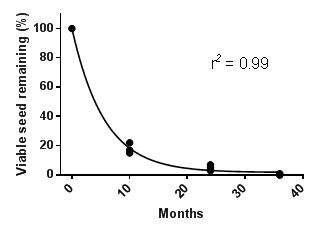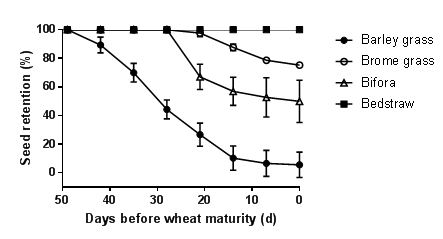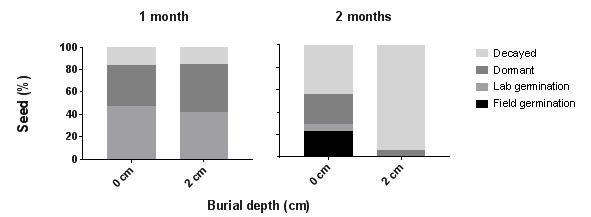Latest research on emerging weeds - brome grass, statice and common sowthistle
Author: Sam Kleemann, Benjamin Fleet and Gurjeet Gill (School of Agriculture, Food & Wine, The University of Adelaide) | Date: 18 Jul 2017
Take-home messages
- Increasing incidence of brome grass in cropping paddocks in southern Australia appears to be associated with the selection of biotypes with greater seed dormancy by weed management practices used by growers.
- Higher levels of seed dormancy allows brome to germinate and establish after pre-sowing weed management, resulting in greater in-crop weed establishment. This change in weed behaviour could have also increased seedbank persistence from one year to the next (approximately 25%). Therefore, a multiyear control strategy is required to exhaust seedbanks to low levels. Growers need to plan a three-year weed management program for their cropping rotations.
- Statice (Limonium lobatum, Winged Sea Lavender) has emerged as a weed of concern in the low-medium rainfall areas of southern Australia. Despite seed coat imposed dormancy, statice seed appears to be vulnerable to rapid decay, and provided seed set is controlled effectively, seedbank persistence is likely to be short (2 years).
- Cereal or fallow phases provide the best opportunity for statice control. Precept® (pyrasulfotole + MCPA) appears to provide excellent control of rosette plants in pot trials. It should be noted that while Precept is registered for use in cereals, it not registered for the control of statice.
- Sowthistle is on the rise, particularly in lentil crops where management options are limited. Because its seeds possess no dormancy, sowthistle plants can emerge and establish all year round, producing vast quantities of wind dispersed seed (>80,000seeds/m2). Therefore, only a few plants are required to replenish the weed seedbank. Control should focus on seed set prevention.
Background
Changes in farming systems and farm management practices are resulting in a changing weed spectrum across the cropping regions of Australia. Many species that were important weeds in pastures, have now become serious weeds of crops. Feedback from growers and consultants indicates that brome grass, statice and common sowthistle have become more difficult to manage in the low rainfall districts of South Australia and Victoria. In order to effectively control these emerging weeds, growers are now seeking information on their behaviour especially on seedbank persistence. However, information on seed biology and persistence of weed seedbanks of many of the emerging weeds in Australia is largely unknown. Furthermore, much of the Australian research on weed seed biology was undertaken prior to the intensification of cropping and before the introduction of no-till systems. It is quite likely that the behaviour of many weeds has changed considerably in response to the changes in crop management practices.
Brome grass ecology and management
Brome grass (B. diandrus, Great brome) has increased in prevalence across the Victorian Mallee with increased adoption of no-till farming and with the intensification of cereal-based cropping systems (i.e. wheat on wheat), where few effective selective herbicides are available for its control. Similar trends of increasing dominance of brome have been observed in SA Mallee and many other areas of the state. Some of the increase in abundance can also be explained by adoption of earlier sowing or even dry sowing. Where brome has become a serious issue it can reduce wheat yields by as much as 30% to 50% (Gill et al. 1987).
On-farm selection for increased seed dormancy has also been responsible for increasing dominance of this weed species. Our research has clearly shown higher levels of seed dormancy in brome grass populations collected from cropping fields than those from non-crop situations such as fence-lines or roadsides (Figure 1). Populations collected from intensively cropped situations at the end of 2015 were much slower to emerge and reach 50% of final emergence (t50) than those sourced from the fence-line (cropped t50 ~40 days; fence-line t50 ~20 days). This difference in seedling emergence between brome populations was related to the variation in seed dormancy.
Figure 1. Differences in germination and seedling emergence pattern between cropped (closed symbols; solid line) and adjacent fence-line (open symbols; broken line) populations of great brome collected in 2015 across south-eastern Australia.
These results clearly indicate that management practices used by farmers to control brome in cropping paddocks have caused a shift in weed population behaviour. This increase in seed dormancy has been caused by selection for individuals in these populations that possess greater seed dormancy that enables them to escape pre-sowing weed control tactics such as tillage or knockdown herbicides. The process of selection for increased seed dormancy would be similar but slower than the selection for herbicide resistance. Over time weed management in cropping paddocks would select for biotypes that possess higher dormancy and select against or remove those with low dormancy.
Seed of highly dormant populations of brome grass were responsive to chilling (i.e. exposure to 5°C), a process which has been shown to increase gibberellic acid production within the seed, a hormone known to stimulate germination. In the field this means that the dormant brome grass requires not only moisture, but also a period of colder temperatures to germinate. Therefore, germination of most of the seedbank of brome would not occur until cooler-moist conditions in late autumn-early winter, thus allowing it to evade early season weed control tactics (e.g. knockdown herbicides). Another biological mechanism that appears to be contributing to delayed emergence is the strong inhibitory effect of light on seed germination in brome grass. Strong photo-inhibition is likely to aid brome infestation in the field by enabling seeds to remain ungerminated on the soil surface until after sowing of the crop, thus preventing seedlings from being killed by seed-bed preparation. This feature of brome grass ecology also goes some way to explaining why it has proliferated under no-till, where seeds remain on the soil surface until being buried by the sowing pass, which would remove the inhibitory effect of light.
Figure 2. Longevity of brome grass seed in the field at Lock from 2003 to 2006.
Greater seed dormancy within in-crop brome grass populations could have also contributed to development of more persistent seedbank. A field study undertaken at Lock showed that 20% of the seedbank of brome persisted from one season to the next, with seeds remaining viable on soil surface for up to three years (Figure 2). Similar levels of persistence were also shown in the long-term study at Balaklava, where more than 25% of seedbank persisted from one season to the next. Seedbank carryover of this magnitude could be an important factor in the proliferation of brome grass where crop rotations have often provided only a single year’s intervention (i.e. pasture-wheat rotation) or under cereal monoculture where few effective herbicide options have been available in the past.
If long-term control of brome is to be achieved, given the persistence of seedbank in the soil, then effective multiyear management is required to deplete the weed seedbank. Fortunately, the introduction of imidazolinone-tolerant wheat (Clearfield®) has widened grower’s options for the management of brome in the wheat cropping-phase. Alternatively break crops, either legume or canola, can provide a range of options for brome control and can be included in a rotation to prevent seed set. However, brome is a prolific seed producer (80 to 270 seeds/plant) and weed populations can rebound sharply if weak management tactics are used for its control.
At present there is growing interest in the grains industry in harvest weed seed control (HWSC) tactics including weed seed catchers and weed seed destructor technologies. The effectiveness and therefore suitability of these practices depends on the amount of weed seed present above cutter bar height at crop harvest. A study undertaken at Roseworthy last season showed that relative to barley grass, brome grass was much slower to shed seed and showed much higher seed retention (75% versus 6%) at crop maturity (Figure 3.). However, lodging of brome grass plants before crop harvest could cause large reduction in weed seed capture. In 2016, even though most of brome seed was retained until harvest, most brome grass panicles (30-80%) were positioned well below the average crop harvest height of 15 cm. These preliminary results suggest that HWSC tactics are likely to have limited success in brome grass management.
Figure 3. Seed retention of brome grass (hollow circle) relative to barley grass (solid circle), bifora (hollow triangle) and bedstraw (solid square) in relation to wheat maturity (≤12% grain moisture content) at Roseworthy in 2016. Bars show ± SE.
Statice ecology and management
Statice (Limonium lobatum, Winged Sea Lavender) is emerging as a weed of concern in the low to medium rainfall areas of southern Australia. Field surveys undertaken in this project have found statice to be more problematic and localised to areas of the SA Upper north and Mallee, and western districts of Victoria. Although little information is available on its ecology, there is evidence to suggest that it behaves like a winter annual, germinating over late autumn early winter and producing seeds over spring. However, there is currently no Australian information on seed biology and germination of statice. Consequently a number of studies were undertaken to determine the effects of temperature, light, scarification (physical and sodium hypochlorite (NaOCl)), salt stress and burial depth on germination and persistence of statice.
A summary of project findings on seed biology of statice thus far:
- Freshly produced seed of statice was highly viable (>95%) but highly dormant, with no germination until two months after maturity.
- More than 60% to80% of seeds remained dormant even after 8 months.
- Seeds were capable of rapid imbibition taking less than 48 hours to fully imbibe, which means seed dormancy was not related to hard seed coat.
- Germination was stimulated by light, with greater than 90% of seeds emerging from the soil surface; clear preference for no-till systems.
- Optimal temperature for germination ranged from 15 to 25oC and germination was inhibited by low temperatures (5oC); therefore statice is more likely to emerge in the field after rainfall events in winter and early spring that maintain adequate soil surface moisture to initiate imbibition.
- Even though statice does not have an impermeable (hard) seed coat, dormancy was regulated by the seed coat, and was overcome by scarification (i.e. cutting seed) or treatment with sodium hypochlorite; dormancy was partially overcome with treatment by gibberellic acid (GA3).
- Statice seeds can germinate under saline conditions which explains prevalence in areas where salinity is known to be a problem.
A field study was also undertaken at Roseworthy to investigate the effect of seed burial on seedbank persistence of statice. Previous research has shown that the depth of burial by tillage can have a large effect on the persistence of seedbanks. Even after a short period, seeds of statice present on the soil surface or buried at shallow depth (2cm) were vulnerable to decay, and lost 20% viability within one month and more than 95% viability after two months burial (2cm; Figure 4). These preliminary results suggest that seedbank persistence is likely to be short for statice, and therefore, high fecundity (seed set) is likely to be a more important factor in the persistence of this weed in the field.
Figure 4. Effect of burial depth on seed fate of statice collected from Warnertown, SA, after 1 and 2 months in the field.
Tactics that focus on seed set control of statice are likely to have a substantial impact on its management. However, achieving effective control with herbicides has been an issue as evident in a pot study at Roseworthy where group B herbicides, Eclipse® (metosulam), Raptor® (imazamox) and Logran® (triasulfuron) and mixtures of glyphosate (e.g. Raze® as used in trial) plus Goal® were ineffective on statice (<42% control). However, group C herbicides Igran® (terbutryn) and diuron applied as tank mixes with MCPA and Ally were extremely effective (92% to 99%). Precept® (MCPA and pyrasulfotole) appeared to be the most effective option (100%) (Table 1)ɸ. While these options have potential to provide control in cereals, management in pulse crops is far more difficult where limited herbicide options are available and these are less effective (i.e. Raptor®, Broadstrike®, data not shown).
ɸCurrently there are no herbicides registered for the control of statice with post emergent application in-crop.
Treatments | Control % (30 DAT) |
|---|---|
Eclipse® @ 50mL/ha + Activator (0.2% w/v) | 11 |
Raptor® @ 45g/ha + Activator (0.2% w/v) | 20 |
Amicide Advance® @ 1.5L/ha | 32 |
Logran® @ 15g/ha + Hasten (1% w/v) | 39 |
Jaguar® @ 1L/ha | 41 |
Raze® (glyphosate) @ 1L/ha + Goal® @ 75mL/ha | 42 |
Diuron (900) @ 280g/ha + MCPA (750) @ 330mL/ha + Activator (0.2% w/v) | 92 |
Igran® @ 550mL/ha + MCPA amine @ 330mL/ha + Ally @ 5g/ha | 99 |
Diuron (900) @ 280g/ha + MCPA (750) @ 330mL/ha + Ally @ 5g/ha | 99 |
Precept®ɸ @ 1L/ha + Hasten (1% w/v) | 100 |
ɸ Currently there are no herbicides registered for the control of statice with post emergent application in-crop.
Sowthistle ecology and management
Many growers have reported an increasing incidence of sowthistle (Sonchus oleraceus) in their pulse crops, particularly lentils. This is not surprising as lentils are poor competitors against weeds and control is more difficult because of the limited herbicide options available. There is also evidence to suggest that many populations of sowthistle have now developed widespread resistance to the group B herbicides (ALS-inhibitors) (Boutsalis pers. comm.), which could be reducing the effectiveness of the imidazolinone tolerant crops (e.g. lentils).
Studies as part of this project have clearly shown that sowthistle is an opportunistic weed, where plants can rapidly produce large numbers of seed, which can emerge all year round provided soil moisture is adequate for germination from the soil surface. Rainfall in late winter and spring is particularly favourable to successful establishment as plants can avoid the main weed spray timing. Seedbank studies have shown that recruitment of sowthistle is low in the field (i.e. less than 10% of the seedbank). However, sowthistle is known for its prolific seed production (>80,000seeds/m2), and therefore, only a few plants are required to survive and set seed to replenish the seedbank. Furthermore, as the seed has potential for long-range dispersal, seedbanks can often be replenished by wind dispersed seed from adjacent fields or non-crop areas.
Seeds of sowthistle show little or no dormancy and appear to decay rapidly (i.e. within 2 months) from the soil surface (30%) and with shallow burial (40%), suggesting that seedbank persistence is likely to be short. Seedling emergence of sowthistle is also substantially influenced by burial depth with seedlings only emerging from the soil surface, which is consistent with its absolute requirement for light for germination. These results help in explaining the increasing prevalence of sowthistle since the adoption of no-till and stubble retention systems.
Similar to statice, tactics that focus on seed set prevention are likely to have the most impact on sowthistle management. Consider the following:
- Maintain clean fence-lines and other non-crop areas - aim for 100% seed set control.
- In paddocks where sowthistle is known to be a persistent problem, grow a more competitive crop like barley or wheat rather than pulses like lentils where there is high potential for weed invasion and limited options for weed control.
- Optimise weed control in cereals where more herbicide options are available, spray small plants and avoid herbicide applications during times of water stress.
- Control out of season germinations (i.e. over summer) with timely use of knockdown herbicides.
Acknowledgments
The research undertaken as part of this project is made possible by the significant contributions of growers through both trial cooperation and the support of the GRDC — the author would like to thank them for their continued support. We are also grateful to Jerome Martin and Malinee Thongmee from The University of Adelaide for providing technical assistance.
References
Gill, G. S., M. L. Poole, and J. E. Holmes. 1987. Competition between wheat and brome grass in Western Australia. Aust. J. Exp. Agric. 27:291–294.
Contact details
Sam Kleemann
Waite Campus, PMB 1, Glen Osmond, SA, 5064
(08) 8313 7661
samuel.kleemann@adelaide.edu.au
Gurjeet Gill
Waite Campus, PMB 1, Glen Osmond, SA, 5064
(08) 8313 7744
gurjeet.gill@adelaide.edu.au
GRDC Project Code: UA00156,
Was this page helpful?
YOUR FEEDBACK




